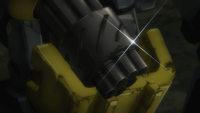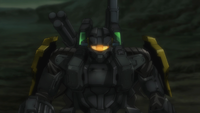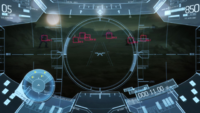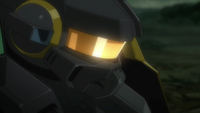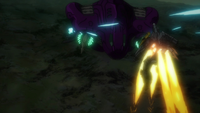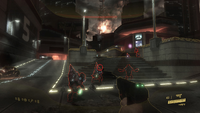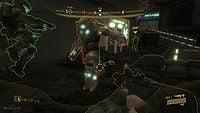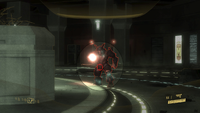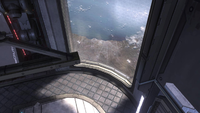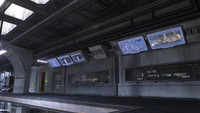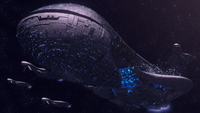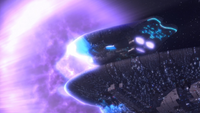Archive:Halo Waypoint/2009 to 2014/Universe/Technology: Difference between revisions
From Halopedia, the Halo wiki
| Line 97: | Line 97: | ||
===Modular Dispersal Technology=== | ===Modular Dispersal Technology=== | ||
{{Article Quote|Test...}} | {{Article Quote|Test...}} | ||
Unlike humanity, whose technological breakthroughs were achieved through exploration and iteration, the Prophets and Elites leveraged found Forerunner artifacts for many of their own advances. Reverse engineering these relics allowed the Covenant to progress in a variety of areas from general materiel technology to extremely precise Slipstream space manipulation. But on occasion, these artificial technical advancements would reveal the Covenant’s misunderstanding and general ignorance of the Forerunners’ intended use of those relics found by the Covenant. | |||
One prominent example of this has been catalogued by the UNSC as “MDT” or Modular Dispersal Technology—the large-scale, rapid disassembly of Covenant starships while in a vacuum and, in some situations, during the course of a battle. When vessels were significantly damaged or suffering from atmospheric breaches, rather than immediately return the craft to a shipyard or repair center, the Covenant could simply detach noncritical sections and continue to operate—some ships even retaining the capacity to enter Slipspace. | |||
Due to the modular architecture of Covenant ships, a damaged vessel could fully function even after scuttling large portions of its hull and general mass. Upon returning to a refitting station, the ship could then be reconstituted and redeployed with minimal loss. This functionality is easily reconciled with the Covenant’s broader design rationale, in that they commonly prefer the use of redundant, simultaneous components, rather than a centralized system for their ships. | |||
Although the Forerunners may have used this technology for this purpose from time to time, it has been determined that the origin of MDT was the Forerunner war with the Flood and that MDT appears to have a different primary purpose for the Forerunners. When the shield and hull of a warship were breached by the implacable parasite, the Forerunners would initiate this measure to disable and scuttle compromised sections of their ships during the battle. The vacuum would then claim whatever Flood remained in the inert portions, providing a somewhat pyrrhic victory against the parasite’s overwhelming dominance. | |||
Only a handful of instances have been recorded in which the Covenant have effectively used this technology in naval combat—and even those remained clouded in mystery. | |||
<gallery> | <gallery> | ||
File:Old HW MDT 1.png|Decision - The commander decides to scuttle the aft section | |||
File:1771440-gallery.png|Concussive Force - Explosions sever the connection to the ship | |||
File:1771441-gallery.png|Slipspace - Some sections remain capable of Slipspace | |||
File:MDT.png|Design - Modular Dispersal Technology conceptualized | |||
</gallery> | </gallery> | ||
*'''Source''': | *'''Source''': [http://halo.xbox.com/en-us/intel/related/gallery/modular-dispersal-technology/e10ac7c3-932c-4b3a-91e5-3bf79c179b68 '''Halo Waypoint''': ''Modular Dispersal Technology''] (defunct, backup on [https://web.archive.org/web/20110314104936/http://halo.xbox.com/en-us/intel/related/gallery/modular-dispersal-technology/e10ac7c3-932c-4b3a-91e5-3bf79c179b68 Archive.org]) | ||
===Booster Frame=== | ===Booster Frame=== | ||
Revision as of 05:43, March 12, 2017
| The following is a verbatim transcription of an official document for archival reasons. As the original content is transcribed word-for-word, any possible discrepancies and/or errors are included. |
Technology
Reach: Implements of War
- Main article: Reach: Implements of War
The UNSC Army has outfitted its soldiers with the best equipment possible, and when that isn't available deep behind enemy lines, they can pry the Covenant's arsenal from the aliens' cold, dead hands.
- Video link: Reach: Implements of War
The Covenant on Reach
- Main article: The Covenant on Reach
The Covenant is a broad and expansive empire of races, governed by a singular military goal: the recovery of Forerunner artifacts. Although the arrival of the Covenant at a human planet - and the bloodbath that always followed - has become almost routine to mankind, the aliens' discovery of Reach is both shocking and ominous. Reach, the UNSC's key military stronghold, is the last line of defense against the Covenant's merciless march of destruction towards humanity's homeworld: Earth.
- Video link: The Covenant On Reach
Prototype
Under the direction of Vice Admiral Danforth Whitcomb, the Office of Naval Intelligence created a number of classified codename projects during the early-to-mid 26th century, including the more publicly-known SPARTAN-II and MJOLNIR programs. Another such program—known simultaneously as HRUNTING and YGGDRASIL—was a nuclear-powered armor defense system which could be operated by a standard UNSC Marine.
Unlike the more compact armor variant of MJOLNIR, HRUNTING/YGGDRASIL’s results would not require extensive and risky biological augmentations for the operator and, as a result, would be much more expensive to design and manufacture. Very few have reported seeing this technology in the field since it remained in a somewhat secretive state well into the war with the Covenant—at least one suit is known to have been deployed in-combat before reportedly being scuppered by ONI as a security precaution.
HRUNTING/YGGDRASIL’s mechanical defense systems and weaponry capabilities are expansive—far outstripping MJOLNIR in almost every way save for bio-ergonomic mobility and size. Although its full technical specifications were never made public, reports have indicated the following components were equipped:
- HRUNTING/YGGDRASIL Mark I Prototype Exoskeleton based on titanium alloy plating and nanocomposite titanium microfiber
- Dynamic Local Dissipative Shield Technology
- T261 Lucifer AMGG (Arm-Mounted Gatling Gun) with 20mm high-explosive rounds, alternate-hand grip stabilizer
- Type-18 Magnetic/Bayonet-style Claymore which can be primed, attached, or otherwise impaled into nonmagnetic surfaces
- Motion Sensor with 1400m+ range (within map mode) across flat surfaces with minimal obstruction
- 2 x Ventral VTOL Stabilizers / 2 x Dorsal VTOL Stabilizer / 4 x Afterburner Thrusters
- LAU-181D/SGM-151 Shoulder-mounted, self-guided high-explosive missiles
- M149 Magellan RCL–armor mounted recoilless rifle with 105mm high-explosive ordnance
Another rumored component was a 300 MT lead-tampered nuclear fission self-destruct sequence (in compliance with Cole Protocol and Winter Contingencies) which would re-use the fusion components of the suit’s power system and begin with a staggered countdown and could only be completed by delivery of a voice command code word—the exact word never having been publicly revealed. This method hints strongly at a kamikaze-style purpose rather than simple security. Since this is illegal under several intact conventions, its official status remains “security.”
- Source: Halo Waypoint: Prototype (defunct, backup on Archive.org)
VISR
When Project: MJOLNIR launched, ONI was forced to mitigate the substantial losses it incurred during the development and real-world production of its armor technology. Because of MJOLNIR’s embedded fusion reactors, each suit of armor costs significantly more than any other comparative item within the ONI's Special Operations budget—estimated to be somewhere near the cost of a standard warship.
For this reason, the UNSC was committed to the widespread application of a variety of individual technologies derived directly from MJOLNIR, specifically for functional use within the military. The Visual Intelligence System Reconnaissance Class, or VISR, is one of these, now used by a wide spectrum of Special Operations personnel. Unlike the variant used by SPARTAN-II super-soldiers, there is no neural interface prerequisite to the VISR. Despite this, it operates in a very similar manner to the heads-up display incorporated into the Mark V and Mark VI suites of MJOLNIR software.
At its core, VISR is a standard HUD that offers real-time tactical information about the wearer's health, ammunition count, and mission objectives. In addition to this, VISR can store a considerable amount of data for later review, including custom mission intel, navigational layouts, and audio files to assist the user operating behind enemy lines. The most obvious alteration to the existing MJOLNIR version, however, is the ability to view in low-light mode, highlighting allies, enemies, and points of interest with a brightly lit wire silhouette.
- Source: Halo Waypoint: VISR (defunct, backup on Archive.org)
Space Tether
Over two and a half centuries before the war with the Covenant, humankind began construction on the Earth's first orbital space elevator at the coastal city of New Mombasa. It was the first of six such elevators spread across the planet's surface. The orbital space elevator eventually became a common, affordable means of extra-atmospheric conveyance, allowing the UNSC and private corporate entities the ability to ferry large amounts of material and personnel into space at comparatively low costs.
Commonly referred to as "space tethers," the orbital space elevators vary in size and shape, but they are all typically composed of the same raw material. Meshed together as a complex composite of intertwining nano-fibers, these ingredients form a series of massive cords and rings several hundred meters wide. They bind to a grounded set of anchors larger than most buildings which hold the elevator’s structure in place while the Earth spins on its axis. The zenith of the elevator, commonly known as the "orbital" or "terminus," is then pulled taut by the Earth's rotational inertia, sliding into geosynchronous orbit thousands of kilometers above the planet.
While Earth has six space elevators, many planets found within the Outer Colonies have more since there is a heavy human reliance on the production and shipment of agricultural and mineral goods from remote worlds. Prior to the Covenant's invasion, the farming colony of Harvest, for example, had seven elevators, while some mineral-rich worlds had as many as nine.
Of Earth's six elevators, only four remained intact at the end of the 2552 CE. On October 20, 2552, an incident known as the New Mombasa Slipspace Event severed the city's space elevator, spreading its shattered remnants across East Africa. Only weeks later, a separate event—in Havana, Cuba on November 3, 2552—resulted in the destruction of what was known as the Centennial Orbital Elevator.
- Source: Halo Waypoint: Space Tether (defunct, backup on Archive.org)
Modular Dispersal Technology
Unlike humanity, whose technological breakthroughs were achieved through exploration and iteration, the Prophets and Elites leveraged found Forerunner artifacts for many of their own advances. Reverse engineering these relics allowed the Covenant to progress in a variety of areas from general materiel technology to extremely precise Slipstream space manipulation. But on occasion, these artificial technical advancements would reveal the Covenant’s misunderstanding and general ignorance of the Forerunners’ intended use of those relics found by the Covenant.
One prominent example of this has been catalogued by the UNSC as “MDT” or Modular Dispersal Technology—the large-scale, rapid disassembly of Covenant starships while in a vacuum and, in some situations, during the course of a battle. When vessels were significantly damaged or suffering from atmospheric breaches, rather than immediately return the craft to a shipyard or repair center, the Covenant could simply detach noncritical sections and continue to operate—some ships even retaining the capacity to enter Slipspace.
Due to the modular architecture of Covenant ships, a damaged vessel could fully function even after scuttling large portions of its hull and general mass. Upon returning to a refitting station, the ship could then be reconstituted and redeployed with minimal loss. This functionality is easily reconciled with the Covenant’s broader design rationale, in that they commonly prefer the use of redundant, simultaneous components, rather than a centralized system for their ships.
Although the Forerunners may have used this technology for this purpose from time to time, it has been determined that the origin of MDT was the Forerunner war with the Flood and that MDT appears to have a different primary purpose for the Forerunners. When the shield and hull of a warship were breached by the implacable parasite, the Forerunners would initiate this measure to disable and scuttle compromised sections of their ships during the battle. The vacuum would then claim whatever Flood remained in the inert portions, providing a somewhat pyrrhic victory against the parasite’s overwhelming dominance.
Only a handful of instances have been recorded in which the Covenant have effectively used this technology in naval combat—and even those remained clouded in mystery.
- Source: Halo Waypoint: Modular Dispersal Technology (defunct, backup on Archive.org)
Booster Frame
- Source:
Gauss Technology
- Source:
Drop Pod
- Source:
The MJOLNIR Project
- Main article: The MJOLNIR Project
